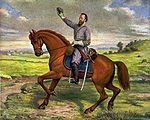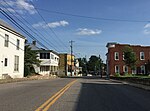Jackson's Valley campaign, also known as the Shenandoah Valley campaign of 1862, was Confederate Maj. Gen. Thomas J. "Stonewall" Jackson's spring 1862 campaign through the Shenandoah Valley in Virginia during the American Civil War. Employing audacity and rapid, unpredictable movements on interior lines, Jackson's 17,000 men marched 646 miles (1,040 km) in 48 days and won several minor battles as they successfully engaged three Union armies (52,000 men), preventing them from reinforcing the Union offensive against Richmond.Jackson suffered an initial tactical defeat (his second defeat of the war) at the First Battle of Kernstown (March 23, 1862) against Col. Nathan Kimball (part of Union Maj. Gen. Nathaniel P. Banks's army), but it proved to be a strategic Confederate victory because President Abraham Lincoln reinforced the Union's Valley forces with troops that had originally been designated for the Peninsula campaign against Richmond. Following Kernstown, Jackson retreated to form a line at Stony Creek south of Woodstock, making his headquarters at Narrow Passage on Stony Creek. It was there he summoned a local cartographer, Jedediah Hotchkiss, who recommended he withdraw from the indefensible Stony Creek to Rude's Hill, a strategic small promontory but a commanding defensive position astride the Valley Turnpike south of Mt. Jackson. It was at Rude's Hill, which was Jackson's headquarters from April 2–17, that Jackson reorganized his command. Jackson had instructed Hotckiss to "make me a map of the Valley, from Harper's Ferry to Lexington, showing all the points of offence and defence [sic] in those places." The Shenandoah Valley had never been comprehensively mapped before, and Hotchkiss' maps and knowledge of the terrain proved to be a decisive tactical advantage for Jackson throughout the rest of the campaign.
On May 8, after more than a month of skirmishing with Banks, Jackson moved deceptively to the west of the Valley and drove back elements of Maj. Gen. John C. Frémont's army in the Battle of McDowell, preventing a potential combination of the two Union armies against him. Jackson then headed down the Valley once again to confront Banks. Concealing his movement in the Luray Valley, Jackson joined forces with Maj. Gen. Richard S. Ewell and captured the Federal garrison at Front Royal on May 23, causing Banks to retreat to the north. On May 25, in the First Battle of Winchester, Jackson defeated Banks and pursued him until the Union Army crossed the Potomac River into Maryland.
Bringing in Union reinforcements from eastern Virginia, Brig. Gen. James Shields recaptured Front Royal and planned to link up with Frémont in Strasburg. Jackson was now threatened by three small Union armies. Withdrawing up the Valley from Winchester, Jackson was pursued by Frémont and Shields. On June 8, Ewell defeated Frémont in the Battle of Cross Keys and on the following day, crossed the North River to join forces with Jackson to defeat Shields in the Battle of Port Republic, bringing the campaign to a close.
Jackson followed up his successful campaign by forced marches to join Gen. Robert E. Lee for the Seven Days Battles outside Richmond. His audacious campaign elevated him to the position of the most famous general in the Confederacy (until this reputation was later supplanted by Lee) and has been studied ever since by military organizations around the world.









